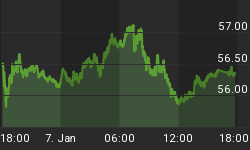You never buy a car without "looking under the hood" to see the condition of the car's most important part ... the motor. The outside of the car may appear beautiful, but the engine may be in poor shape. The message here, is that investors should investigate the market's condition in the same manner.
A look "Under the Hood" on what Institutions are doing behind the scenes ...
Today's analysis will show you what Institutional market support "appears" like on the surface, and what they are doing behind the scenes.
To do this, we will look at the NYA Index (New York Stock Exchange Index) because the majority of the volume on this index are Institutional trades, and it is where the big program trading occurs.
Chart 1: Our first chart below shows a typical picture that most analyst would see. When you look at the NYA's price bars ... definite trends, confined within rising and dropping channels become apparent.
When you look at the price channels below, it is apparent that the NYA has been in an up channel since the beginning of last November. If you look closely, the first crack has just appeared with the NYA's price recently breaking its channel's support to the downside.
Yesterday, the NYA Index re-tested its channel's resistance and successfully closed within the channel again.
So what does this mean? ... Is the up trend still in place, or has it suffered important damage?
From a pure trend stand point, our Long Term Trend Reversal Indicator (green indicator at the top of the chart), has not broken its blue support line yet.
Okay ... the trend may not be over yet ... but what does the NYA's prospects look like when you look "under the hood"? See Chart 2 ...

Chart 2: There are many ways that an analyst can look "under the hood" in this situation.
One important one we look at is Advancing Issues.
As long as Advancing Issues on the NYA are on the rise, then the market has to go up as it signifies that money is moving in the market and stocks are in accumulation.
When Advancing Issues are declining, then that signifies that money is drying up relative to the acquisition of more stock shares which usually correlates with a market opinion that stocks are getting too expensive ... or that there may not be enough upside left to chase.
Just measuring the quantitative side of Advancing Issues will not normally give you the picture of what is happening "under the hood" ... until the engine stops. So, how and what do you measure for the real picture?
One of the Models we created, measure's of the "rate of Acceleration or Deceleration" of Advancing Issues.
If the Advancing Issues are accelerating, then the rule of "a body in motion will continue in motion" will be in play. By the same token, if Advancing Issues are decelerating, then the motion's direction and trajectory will falter and come down just like a ball thrown high into the air will reverse and drop back down to the ground.
So ... what is happening to the Acceleration/Deceleration of the NYA's Advancing Issues?
If you look at our chart below, you can see clear "cycles" of up and down Acceleration and Deceleration of Advancing Issues.
If you look further, the Acceleration produces market up movements until it drops below its critical strength Signal Line. But before it does, you get a warning that Deceleration is starting to occur because the red indicator line starts trending down.
So ... what are Institutions doing now?
If you look at the Acceleration/Deceleration trend, it peaked at the very beginning of January. Since then, it has dropped and made lower tops and lower bottoms ... so it is trending down with deceleration.
The red trend line closed close to its horizontal Signal line yesterday, so it is at an equal-balance level with Acceleration equaling the rate of Deceleration. BUT, the TREND has been in a Deceleration mode since January.
I'm sure you get the concept and what happens when Advancing Issues go into a Deceleration, and what happens when to the market when it does.
Right now, when we "look under the hood" we are seeing Deceleration. Unless this trend reverses, the result will be like all the previous instances on the chart.

Please Note: We do not issue Buy or Sell timing recommendations on these Free daily update pages. I hope you understand that in fairness, our Buy/Sell recommendations and advanced market Models are only available to our paid subscribers on a password required basis.
















